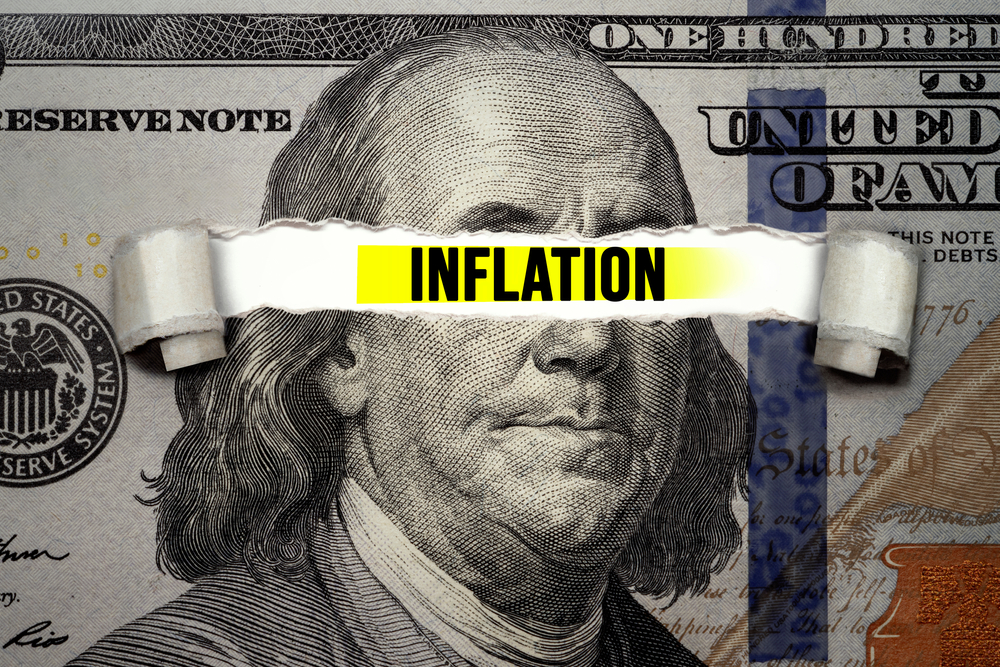Understanding Inflation and Its Impact on Your Retirement
Inflation, a seemingly innocuous economic term, can have profound implications on your retirement savings. It’s a concept that represents the rate at which the general level of prices for goods and services is rising, and subsequently, purchasing power is falling. Central banks attempt to limit inflation, and avoid deflation, in order to keep the economy running smoothly.
However, when it comes to retirement savings, inflation plays a critical role. Imagine you’ve saved a certain amount for your retirement. It might seem like a substantial sum today, but what about 20 or 30 years down the line? With the rise in the cost of living, the same amount of money will not hold the same value. This is where the impact of inflation comes into play.
Inflation erodes the purchasing power of money over time. This means that with each passing year, the same amount of money will buy you less and less. For retirees, this could mean that their carefully accumulated nest egg might not stretch as far as they had planned. This is particularly concerning for those on fixed incomes, as their income does not increase with inflation.
For instance, consider a retirement savings of $500,000. It might seem like a lot today, but with an average inflation rate of 2% per year, in 20 years, you would need approximately $740,000 to have the same purchasing power that $500,000 has today. That’s a significant decrease in the value of your savings due to inflation.
Therefore, understanding inflation and its impact is crucial for effective retirement planning. It’s not enough to simply save a certain amount for retirement. One must also consider the future value of that money and plan accordingly to ensure that their savings will be sufficient to maintain their desired lifestyle in their golden years.
Inflation and Your Retirement Savings
Inflation, a silent force that erodes the purchasing power of money over time, can have a significant impact on retirement savings. For those planning for retirement, it is important to understand the relationship between inflation and retirement savings.
When individuals save for retirement, they are not just saving for a future date. They are saving for the future costs of living, which rise over time due to inflation. This means that a $1 million retirement goal set today could fall short of providing the same standard of living when retirement rolls around.
For example, if the annual inflation rate averages 2%, the cost of living will double in approximately 36 years. This means that if today’s expenses amount to $50,000 per year, in 36 years, it would take $100,000 to maintain the same lifestyle. For those with a retirement horizon of several decades, the impact of inflation can be substantial.
Certain costs, like healthcare, often experience inflation rates higher than the average, posing additional challenges for retirees. The rising cost of healthcare services can significantly affect retirees, who typically have higher healthcare needs.
Inflation also impacts the real return on retirement savings. The real return is the investment return minus the inflation rate. For instance, if a retirement account earns a 7% return in a year, but inflation is 2%, the real return is only 5%. Over time, this reduced earning power can significantly affect the growth of retirement savings.
In essence, inflation is a critical factor that can shape the adequacy of retirement savings. It is not enough to just save; one must save and invest wisely to ensure that the growth of their retirement savings outpaces inflation, preserving the purchasing power of their nest egg. This understanding forms the basis for more advanced strategies to inflation-proof retirement savings, which we will explore in the subsequent sections.
Historical Trends of Inflation
Inflation, as measured by the Consumer Price Index (CPI), has seen various shifts over the decades. The CPI is an indicator that measures the average change over time in the prices paid by urban consumers for a market basket of consumer goods and services. It’s a widely used measure of inflation and is often used to adjust dollar values for inflation when comparing dollar amounts from different periods.
In the United States, for example, the 1970s and early 1980s were periods of high inflation, with annual rates often exceeding 5% and even reaching double digits. This era was followed by a period of relative stability and lower inflation from the mid-1980s through the early 2000s. However, the financial crisis of 2008 led to a brief period of deflation, followed by a return to modest inflation rates.
These historical trends underscore the fact that inflation is not a static or predictable force. It fluctuates in response to various economic factors, including monetary policy, economic growth, and global events. For those planning for retirement, these trends serve as a reminder of the importance of factoring inflation into their savings strategies.
While past performance is not indicative of future results, understanding these historical trends can help individuals better prepare for potential inflationary periods. This knowledge can inform investment strategies and contribute to more robust and resilient retirement planning. After all, a well-informed saver is a well-prepared saver.
Strategies to Counteract the Impact of Inflation on Your Retirement
One of the most effective strategies to combat inflation is to invest in assets that have the potential to outpace it. Equities, or stocks, have historically provided higher returns over the long term than other investment types. While they come with higher risk, the potential for higher returns can make them a valuable part of an inflation-fighting portfolio.
Diversification is another key strategy. Spreading your investments across a variety of asset classes can help manage risk and potentially enhance returns. This could mean a mix of stocks, bonds, real estate, and commodities. Each of these asset classes reacts differently to inflation, and having a mix can provide a level of protection.
Inflation-protected securities, such as Treasury Inflation-Protected Securities (TIPS) in the U.S., are designed to help protect investors from inflation. The principal of a TIPS increases with inflation, as measured by the Consumer Price Index, ensuring that your investment keeps pace with the cost of living.
Also, consider annuities that offer inflation protection. While these can be more expensive than standard annuities, they provide income that adjusts with inflation, helping to preserve your purchasing power in retirement.
Lastly, don’t overlook the role of Social Security benefits. In the U.S., these benefits are adjusted for inflation each year, providing a source of income that keeps pace with rising prices.
It is important to review your retirement strategy regularly and adjust as needed. Inflation is just one of many factors to consider, and a financial advisor can provide guidance tailored to your individual circumstances. By being proactive and strategic, you can help ensure your retirement savings will support the lifestyle you envision, regardless of what happens with inflation.
Expert Opinions on Inflation and Retirement Savings
Expert insights can often shed light on complex matters such as the interplay between inflation and retirement savings. These professionals, with their years of experience and deep understanding of financial trends, offer valuable advice to those planning for retirement.
One such expert, renowned economist Dr. Jane Peterson, emphasizes the importance of understanding inflation’s role in retirement planning. She states, “Inflation is like a silent thief, gradually eroding the purchasing power of your retirement savings. It’s crucial to factor it into your retirement planning strategy.” Dr. Peterson recommends regular reviews of one’s retirement plan to ensure it remains aligned with current inflation rates.
Similarly, financial advisor Mark Thompson advises his clients to diversify their investment portfolios as a hedge against inflation. “A well-diversified portfolio that includes assets like stocks, bonds, and real estate can help protect your retirement savings from the adverse effects of inflation,” he suggests.
On the other hand, Sarah Lee, a certified financial planner, advocates for the inclusion of Treasury Inflation-Protected Securities (TIPS) in retirement portfolios. “TIPS can provide an inflation-adjusted return, making them a good option for those concerned about inflation,” she explains.
Lastly, renowned author and financial expert, Robert Kiyosaki, known for his best-selling book “Rich Dad, Poor Dad,” encourages individuals to invest in assets that tend to increase in value with inflation. He often mentions real estate and certain types of commodities as examples.
5 Tips for Inflation-Proofing Your Retirement Savings
Inflation is a general increase in prices and a decrease in the purchasing value of money. It can have a significant impact on retirement savings, as it can erode the value of your investments and make it more difficult to cover your expenses. However, there are steps you can take to inflation-proof your retirement savings, including:
- Diversifying your investment portfolio: A well-diversified investment portfolio can help protect your savings from the effects of inflation by spreading your risk across different asset classes. This means investing in a variety of assets, such as stocks, bonds, and real estate. When one asset class declines in value, another asset class may be increasing in value, which can help to offset your losses.
- Investing in inflation-protected securities: Inflation-protected securities, such as Treasury Inflation-Protected Securities (TIPS), are designed to keep pace with inflation. This means that the value of your investment will increase as the rate of inflation increases. This can help to protect the purchasing power of your savings.
- Investing in real assets: Real assets, such as real estate and commodities, can also help protect your savings from inflation. This is because the value of real assets tends to increase with inflation. For example, if the rate of inflation is 3%, the value of a rental property may also increase by 3%. This can help to offset the effects of inflation on your savings.
- Planning for a longer retirement: People are living longer than ever before, so it’s important to plan for a longer retirement. This means saving more money and investing it more conservatively so that your savings will last as long as you need them to. One way to do this is to increase the amount you save each year. Another way is to invest in assets that are less volatile, such as bonds and CDs.
- Regularly reviewing and adjusting your plan: Inflation rates can fluctuate, so it’s important to review your retirement plan regularly and make adjustments as needed. This will help ensure that your savings are on track to meet your needs in retirement. For example, if the rate of inflation increases, you may need to increase the amount you save each year or invest in more inflation-protected assets.
Planning for Inflation in Your Retirement Strategy
It’s an economic reality that can’t be ignored, subtly chipping away at the purchasing power of our hard-earned savings. However, as we’ve explored throughout this article, it’s not an insurmountable obstacle. With careful planning, strategic investments, and a keen eye on the economic landscape, we can mitigate the impact of inflation on our retirement savings.
The key is to be proactive rather than reactive. This means understanding the potential impact of inflation on your retirement savings and taking steps to protect your financial future. Diversification of your investment portfolio, regular reviews of your retirement plan, and considering inflation-protected securities are all strategies that can help shield your savings from the effects of inflation.
Remember, retirement planning is not a one-size-fits-all process. What works for one person may not work for another. It’s important to consider your individual financial situation, risk tolerance, and retirement goals when crafting your retirement strategy. Consulting with a financial advisor can provide personalized advice tailored to your unique circumstances.
In the end, the goal is to ensure that when you reach your golden years, you have a robust retirement nest egg that allows you to live comfortably, despite the ebb and flow of inflation. By taking inflation into account in your retirement planning, you’re not just preparing for the future; you’re securing peace of mind for yourself in the present.




